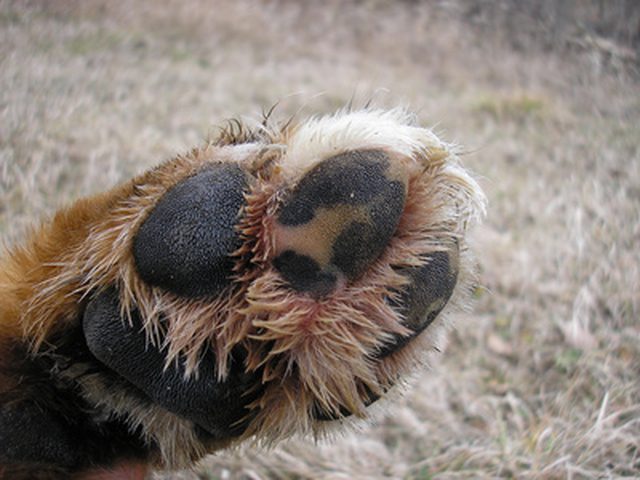Dog Paw Licking: 7 Natural Answers
Excessive Paw Licking In Dogs
Does your dog CONSTANTLY lick his paws?
Lick. Lick. Lick.
It can be very frustrating as a pet parent, especially when some of the things you try are not working.
The most common cause of excessive paw licking is an underlying allergy, making the feet itchy, causing your dog to lick.
Typically the feet become stained from the salivary pigments, so often is the dogs with white fur they become a reddish brown.
The moisture caused by excessive foot licking between the paws can cause a secondary bacterial or yeast infection. This can actually worsen the itchiness and clinical signs.
In both people, dogs and cats, the incidence of allergies is increasing.
Allergy is defined as a hypersensitivity in which exposure to a benign protein (allergen) causes your pet’s immune system to overreact.
Dog Paw with yeast infection
CAUSES
Three main possibilities: external parasites, such as fleas; food—for dogs, beef protein is the most common; environmental, from pollens to house dust mites. The immune system overreacts and causes severe itchiness.
Solutions
1. ELIMINATE the fleas. Practice regular flea control using natural methods, if possible, topical antiparasitics, if necessary.
2. Hypoallergenic Food Trial
Here you are feeding a hypoallergenic diet for ten to twelve weeks to see ifyour dog or cat’s allergic symptoms stop. This is a long time, and fortunately over 80 percent of pets respond at least partially by six weeks, although Labs and cocker spaniels usually need longer trials.
3. THE SUPPLEMENT CONNECTION. Fatty acid supplements are very helpful in decreasing the level of inflammation. Omega-3 fatty acids are most important. The main point is to give a high enough dose to be effective, and the ideal dose is 1,000mg per ten pounds daily. A great, inexpensive source is flax oil; I give 1 tablespoon per fifty pounds. Other sources include primrose oil and specific veterinary supplements.
4. FEET WASHING. Regularly washing of your dog’s paws after they come in from being outside is one of the best ways to decrease the itching; this washes off the outdoor allergens. You can use a damp cloth or put your pup in the bath.
5. SOOTHE IT TOPICALLY. HERBAL CREAMS. There are a few herbs to consider topically: Licorice gel, chamomile cream, and topical curcumin.
Licorice and curcumin ointment are herbal medications that has been successfully used to relieve the itch. Apply a thin coat twice daily to affected areas.
6. ANTIHISTAMINES. Benadryl is the most commonly used antihistamine. It is given at a dose of 1 mg per pound of body weight, two to three times a day. It is best to consult your veterinarian before using these medications. It often takes fourteen days of using these to see if they are helping.
7. Treat the YEAST. Yeast are often a secondary organism that grows on your dog’s skin with underlying allergies and paw licking. One option is to make your own anti-yeast wash of 1 cup of green tea, 2 tablespoons of Apple Cider Vinegar – wipe your dog’s paws with this mixture twice daily. Another option is to purchase a ‘human’ OTC anti-fungal cream such as Canesten and apply that twice daily as needed.
Best Wishes,
Dr Andrew J
P.S. Dog Paw Licking is often difficult to treat, and usually means ongoing treatment – in general veterinary medications such as prednisone are only stopping the symptoms, NOT getting to the underlying cause.
They also often have side effects such as Increased drinking, Increased urination, – never mind less common ones such as diabetes.
Best to try some of the holistic options which are also in my supplement, Ultimate Canine Health Formula.
If you have yet to try it you can do so now for 37%OFF and No Autoship

My Daisy is constantly licking her paws. They have turned really brown as well.
The brown-ish colour is often from saliva staining (the dog licks the paws a lot so the fur/pads turn brown). One of the most common causes of constant paw-licking is an underlying allergy (food, fleas or environmental) and then secondary issues like bacterial/yeast infections set in.
What to try (natural steps per his article):
Start a hypoallergenic diet trial (10–12 weeks) to test if food allergies are the root cause. Add Omega-3 fatty acid supplements (to reduce inflammation) — e.g., he recommends approx 1,000 mg per 10 lbs body weight for dogs. Wash her paws regularly after being outside to remove allergens, dirt, etc. If a yeast or infection is suspected (which brown staining may indicate), he suggests a natural foot soak of green tea + apple cider vinegar, twice daily.